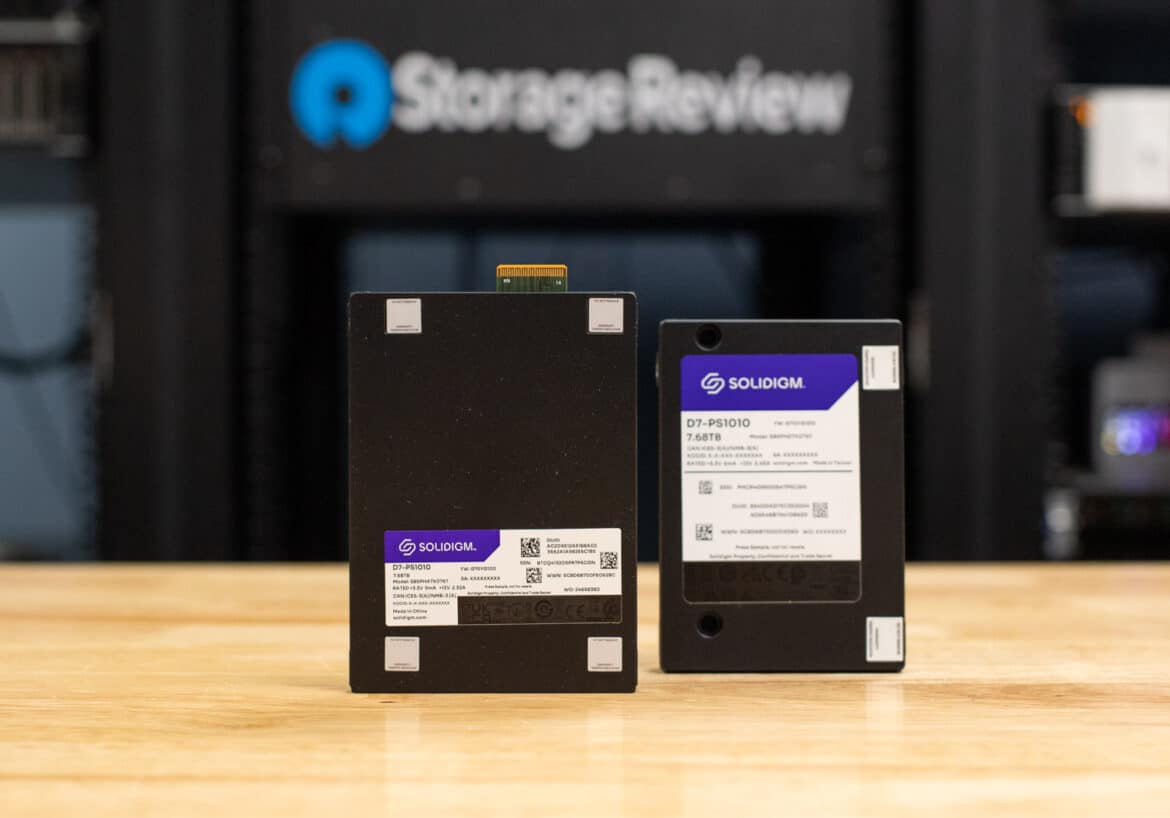The Solidigm PS1010 is a standout choice for enterprises looking to optimize their data center operations with a high-performance SSD.
The Solidigm D7-PS1010 is a high-performance PCIe 5 SSD designed for demanding enterprise and cloud data center workloads, particularly in AI/ML data pipelines. This SSD is part of Solidigm’s extensive portfolio, offering capacities ranging from 1.92TB to 15.36TB in form factors like U.2 and E3.S. Built for standard endurance applications, the PS1010 promises class-leading performance and robust reliability, making it suitable for a variety of high-performance computing environments.
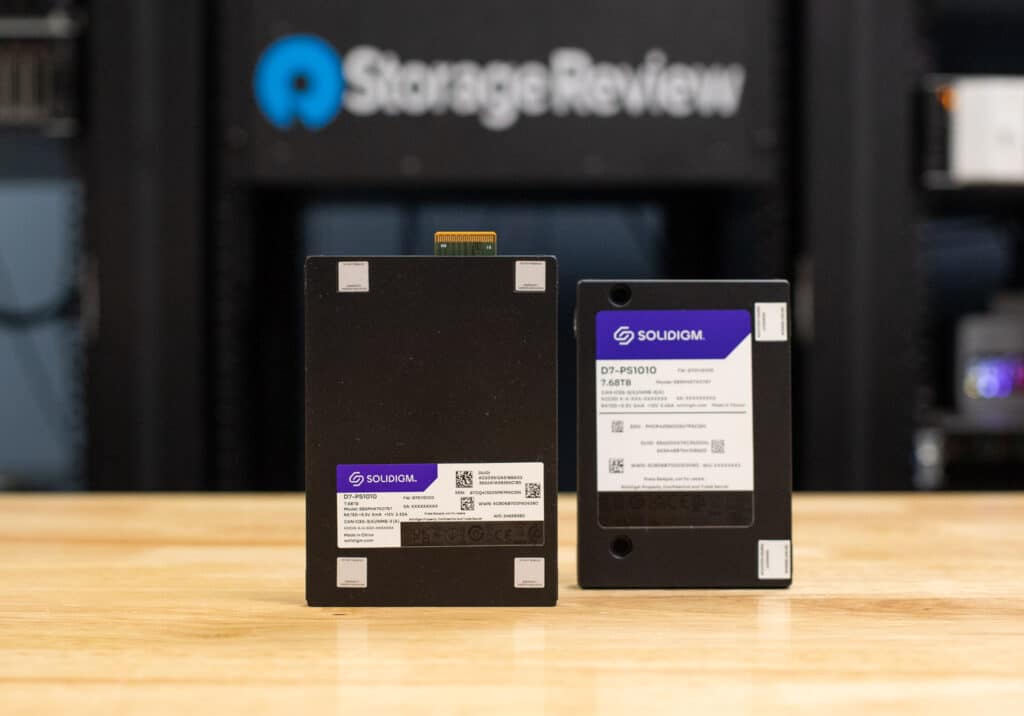
Solidigm PS1010 E3.S Left, U.2 Right
Powered by an updated Gen5 interface and 176-layer TLC 3D NAND, the Solidigm PS1010 is quoted with impressive performance numbers. This drive claims sequential read speeds of up to 14,500 MB/s and sequential write speeds of up to 9,300 MB/s. Its random read and write performance is equally impressive, with up to 3.1 million IOPS for reads and up to 400,000 IOPS for writes. Solidigm indicates that this performance is achieved with an average active power consumption of 23W and an idle power of 5W, making it energy efficient without compromising speed. Moreover, its support for multiple power states allows users to balance performance with energy efficiency based on their needs.

Solidigm PS1010 E3.S Stacked on U.2
The Solidigm PS1010 includes features to ensure data integrity and security. It supports NVMe 2.0 and NVMe-MI v1.2 specifications and offers high compatibility and manageability across various systems. The drive complies with TCG Opal 2.02 and FIPS 140-3 Level 2 certifications, ensuring robust security through device encryption and secure boot mechanisms. Device attestation verifies that the firmware is authentic and untampered, adding an extra layer of trust. Secure boot ensures that only trusted software is loaded during startup, protecting against unauthorized firmware and bootloader attacks. Additionally, AES-256 XTS encryption safeguards all data stored on the drive, protecting sensitive information even if the drive is physically compromised.
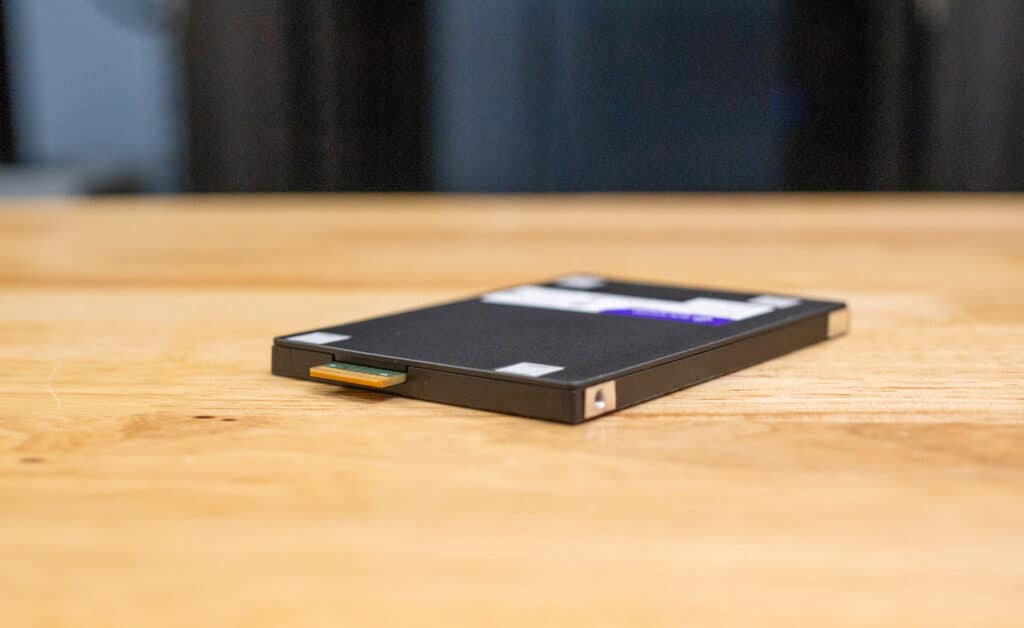
Solidigm PS1010 E3.S
For manageability, the PS1010 provides both out-of-band and in-band NVMe management capabilities. Out-of-band NVMe-MI with SMBus and PCIe-VDM allows system administrators to monitor and manage the SSD through a dedicated interface, offering flexibility and control without affecting primary data paths. In-band NVMe-MI provides direct access to management features over the same interface used for data transfer, simplifying the management process and reducing the need for additional hardware.
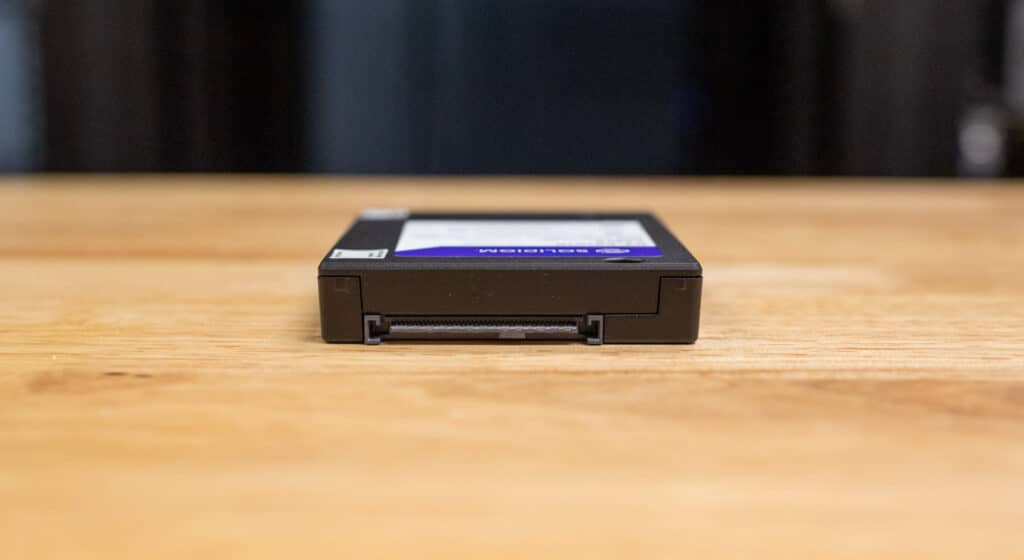
Solidigm PS1010 U.2
As indicated above, this drive is well-suited for AI/ML workloads, offering up to 50% higher throughput in certain pipeline phases than other drives. It is ideal as an NVMe data cache drive in GPU servers or within all-flash high-performance tiers supporting lower-performing storage. Its ability to handle real-world IO conditions effectively makes it suitable for high-performance computing, general-purpose servers, and online analytical processing (OLAP) databases.
Beyond performance, the PS1010 includes advanced data protection features. Enhanced power loss imminent (PLI) testing ensures data is preserved during sudden power failures. The drive also incorporates robust end-to-end data protection with ECC (error-correcting code) covering 99% of the drive’s SRAM, which helps prevent data corruption. Silent data corruption (SDC) susceptibility is modeled to an impressive 1E-25, ensuring high data reliability over the drive’s lifespan.
Solidigm PS1010 Specifications
| Specification | Details |
| Capacity | 1.92TB, 3.84TB, 7.68TB, 15.36TB |
| Form Factor | U.2 (15mm), E3.S (7.5mm) |
| Interface | PCIe 5.0 x4 |
| NAND Type | 176-layer TLC 3D NAND |
| Sequential Read | Up to 14,500 MB/s |
| Sequential Write | Up to 9,300 MB/s |
| Random Read (4KB) | Up to 3,100K IOPS |
| Random Write (4KB) | Up to 400K IOPS |
| Latency (Read) | Up to 60 µs |
| Latency (Write) | Up to 8 µs |
| Endurance | 1.0 DWPD |
| Mean Time Between Failures (MTBF) | 2.5 million hours |
| Uncorrectable Bit Error Rate (UBER) | 1 sector per 1018 bits read |
| Power Consumption (Active) | Up to 23W |
| Power Consumption (Idle) | 5W |
| Operating Temperature | 0°C to 77°C |
| Non-Operating Temperature | -40°C to 85°C |
| Shock (Non-Operating) | 1,000 G (Max) at 0.5ms |
| Vibration (Non-Operating) | 3.13 GRMS (5-800Hz) Max |
| Humidity (Non-Operating) | 5% to 95% (Non-condensing) |
| Altitude (Operating) | -1,000 to 10,000 ft |
| Altitude (Non-Operating) | -1,000 to 40,000 ft |
| Security | TCG Opal 2.02, FIPS 140-3 Level 2, AES-256 XTS encryption |
| Manageability | NVMe-MI v1.2, SMBus, PCIe-VDM, In-band and Out-of-band management |
| Warranty | 5 years |
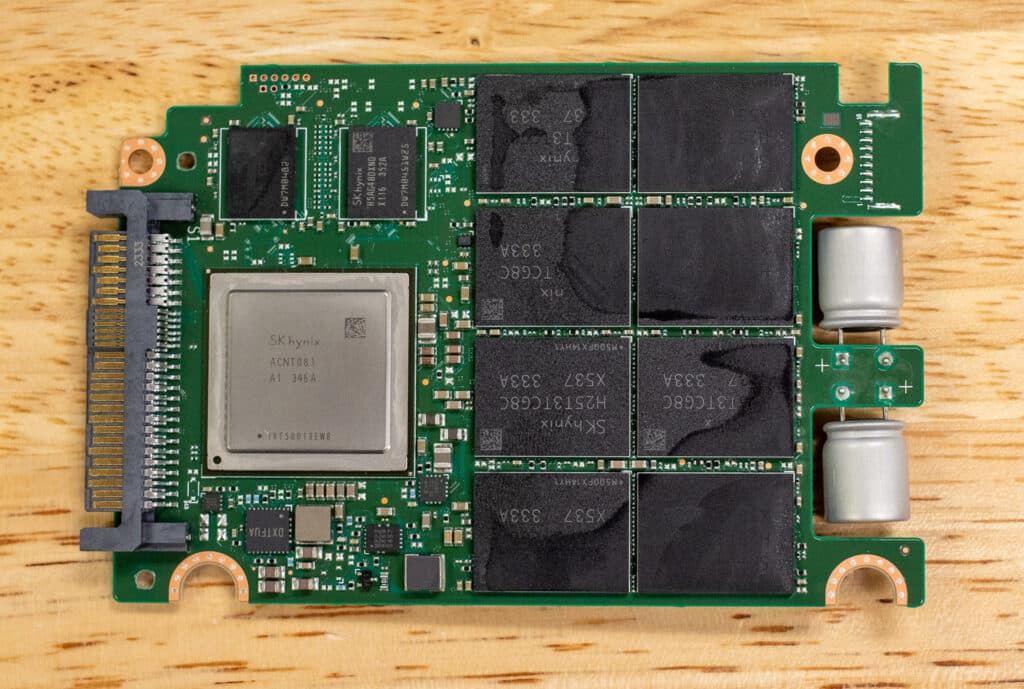
The Solidigm PS1010 is a vertically integrated solution with the controller, firmware, DRAM, and NAND all coming from in-house designs:
- Controller: SK Hynix ACNT081
- DRAM: SK Hynix H5AG48DXND
- NAND: SK Hynix H25T3TCG8C
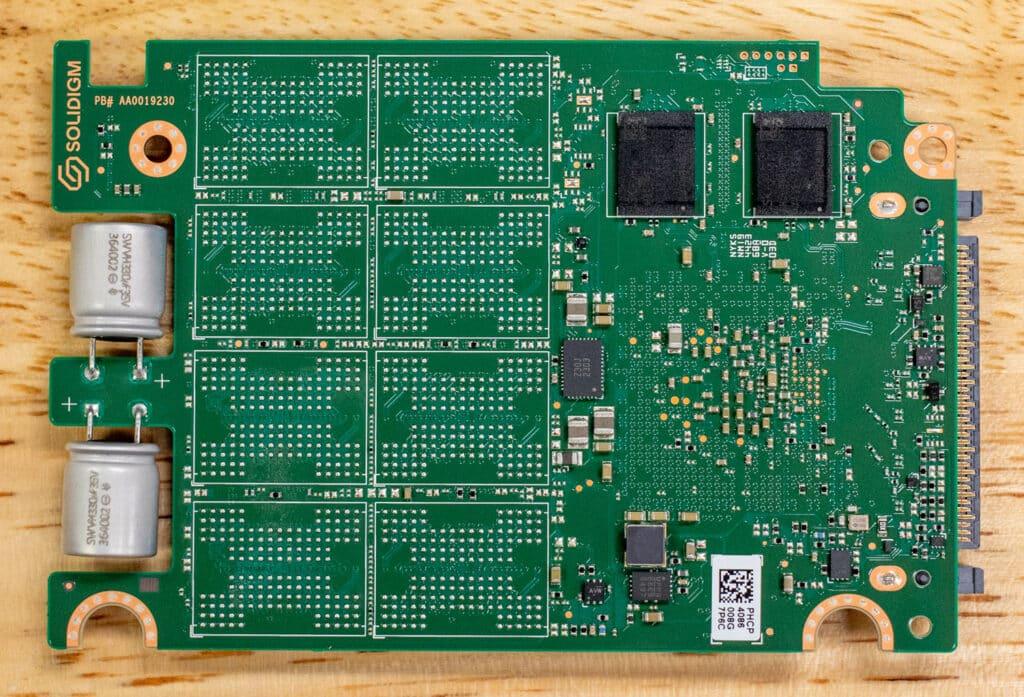
Solidigm also offers the Solidigm Storage Tool (SST) for drive management. The 1.13 version came out in June 2024 and supports Windows, Linux, and ESXi.
Solidigm D7-PS1010 Performance
To test the Solidigm PS1010 Gen5 SSD, we use a Dell PowerEdge R760 in our test lab. It is a highly versatile 2U rackmount server that supports two 4th generation Intel Xeon processors and has configurations that support up to 24 NVMe drives. This server is intended for mixed workloads, databases, and VDI.
Dell PowerEdge R760 Configuration
- Dual Intel Xeon Gold 6430 (32 cores/64 threads, 1.9GHz base)
- 1TB DDR5 RAM
- Ubuntu 22.04
For ultimate flexibility, we also worked with Serial Cables, who supplied us with an 8-bay PCIe Gen5 JBOF for U.2/U.3, M.2, and EDSFF SSD testing. This allows us to test all current and emerging drive types on the same test hardware.
Workload Benchmarking
When benchmarking storage devices, application testing is best, and synthetic testing is second. While not a perfect representation of actual workloads, synthetic tests help baseline storage devices with a repeatability factor that makes it easy to compare apples-to-apples between competing solutions. These workloads offer a range of testing profiles ranging from “four corners” tests and common database transfer size tests to trace captures from different VDI environments.
For this review, we compare the Solidigm PS1010 to the Samsung PM1743, and KIOXIA CM7-R SSDs across all workloads.
fio Peak Performance Analysis
The fio script package we leveraged is an automated script set up to precondition and lightly test drives in a consistent manner, found here on github. We used this to perform 256K sequential read and write tests for peak bandwidth and 4K random read and write tests for peak throughput.
| Peak Throughput and Bandwidth |
Solidigm PS1010 7.68TB | KIOXIA CM7-R 7.68TB | Samsung PM1743 7.68TB |
| 256K sequential read (1T/64Q) | 14,848MB/s | 12,092MB/s | 14,495MB/s |
| 256K sequential write (1T/64Q) | 7,117MB/s | 5,796MB/s | 6,052MB/s |
| 4K random read (8T/32Q) | 2,084,960 IOPS | 1,963,066 IOPS | 1,900,838 IOPS |
| 4K random write (8T/32Q) | 408,721 IOPS | 301,061 IOPS | 319,758 IOPS |
The Solidigm PS1010 7.68TB SSD demonstrates outstanding performance in several key areas compared to its competitors. It leads in 256K sequential read speed at 14,848 MB/s, surpassing KIOXIA CM7-R and Samsung PM1743, making it ideal for read-intensive applications.
In 256K sequential write operations, it performs well at 7,117 MB/s. The PS1010 also shows strong 4K random read performance with 2,084,960 IOPS, outpacing the KIOXIA and Samsung drives. In 4K random writes, the PS1010 had a strong showing, achieving 408,721 IOPS, again leading in front of the Samsung and KIOXIA models.
VDBench Workload Analysis
These tests leverage the typical vdBench workload generator, with a scripting engine to automate and capture results over a large compute testing cluster. This allows us to repeat the same workloads across various storage devices, including flash arrays and individual storage devices. Our testing process for these benchmarks fills the entire drive surface with data and then partitions a drive section equal to 25% of the drive capacity to simulate how the drive might respond to application workloads. This differs from full entropy tests, which use 100 percent of the drive and take them into a steady state. As a result, these figures reflect higher-sustained write speeds.
Profiles:
- 4K Random Read: 100% Read, 128 threads, 0-120% iorate
- 4K Random Write: 100% Write, 128 threads, 0-120% iorate
- 64K Random Read: 100% Read, 128 threads, 0-120% iorate
- 64K Random Write: 100% Write, 128 threads, 0-120% iorate
- 16K Sequential Read: 100% Read, 32 threads, 0-120% iorate
- 16K Sequential Write: 100% Write, 16 threads, 0-120% iorate
- 64K Sequential Read: 100% Read, 32 threads, 0-120% iorate
- 64K Sequential Write: 100% Write, 16 threads, 0-120% iorate
- 4K, 8K, and 16K 70R/30W Random Mix, 64 threads, 0-120% iorate
- Synthetic Database: SQL
- VDI Full Clone and Linked Clone Traces
Random and Sequential Workloads
In our first VDBench test, the Random Read 4K shows the Solidigm PS1010 with throughput at 729K IOPS but having 96.6µs latency, just behind the KIOXIA drive.
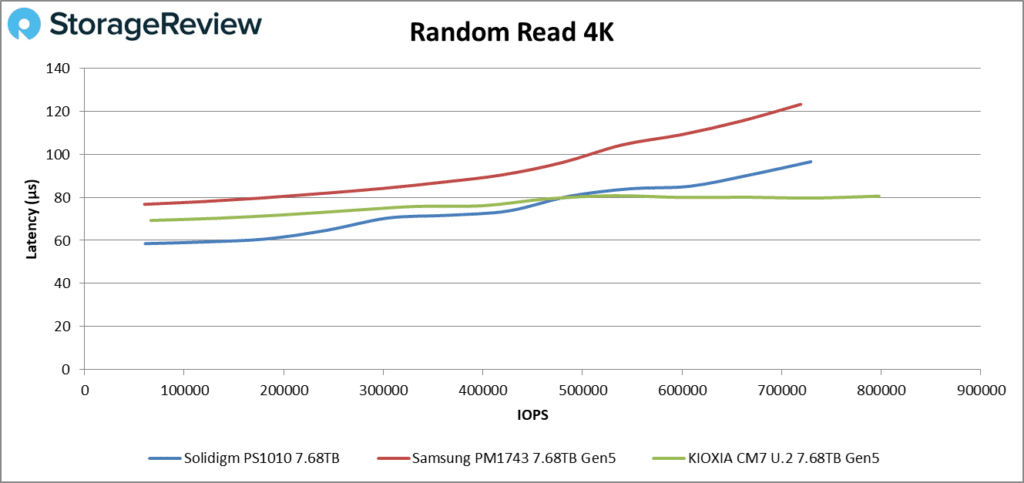 In Random Write 4k, the Solidigm was the top drive, hitting 941K IOPS at 526.7µs in latency. The Samsung and KIOXIA drives lagged with 730K and 700K IOPS, respectively.
In Random Write 4k, the Solidigm was the top drive, hitting 941K IOPS at 526.7µs in latency. The Samsung and KIOXIA drives lagged with 730K and 700K IOPS, respectively.
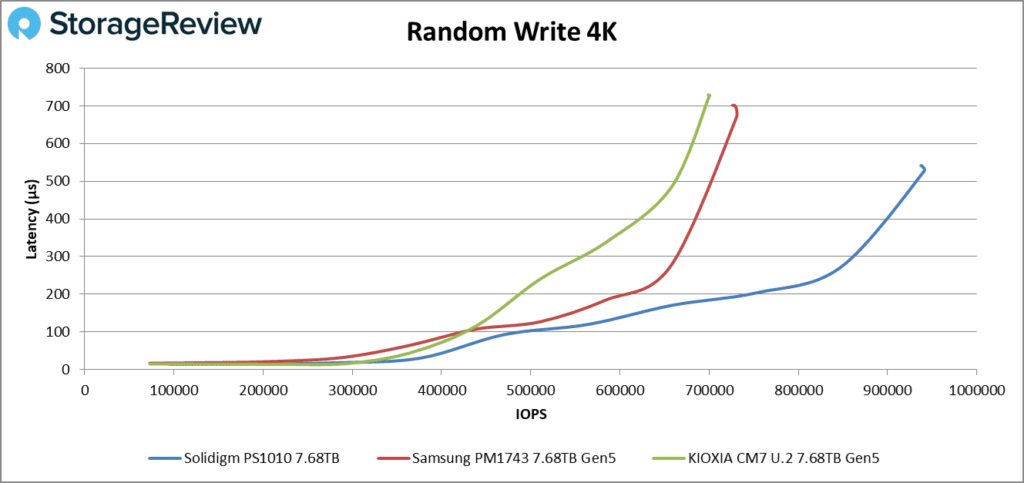
Moving on to random 64K performance, the PS1010 was the top performer by a large margin. In reads, it hit 192K IOPS at 165.9µs in latency, compared to the Samsung PM1742 and KIOXIA CM7 drives, which both ended the test around 145K IOPS.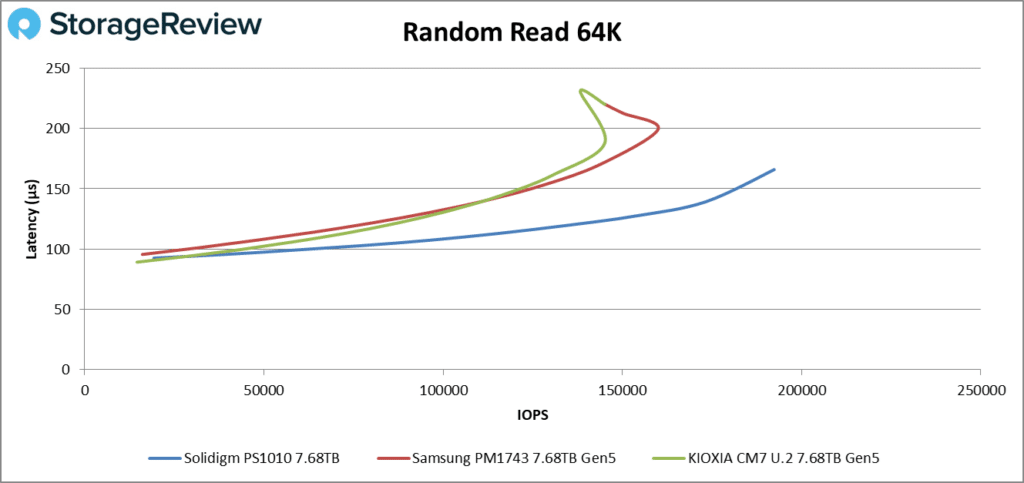
In 64K random write, the PS1010 peaked at 63K IOPS with a latency of 249.1ms.
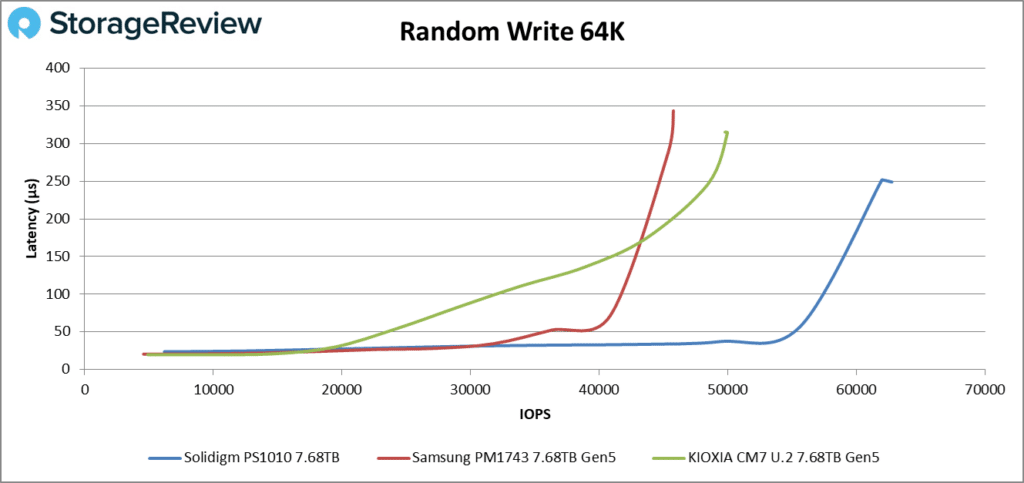
For sequential Read 64K, the Solidigm PS1010 led the pack again with 177K IOPS (11.1GB/s) at 360.8µs in latency. This is noticeably faster than the other two tested drives.
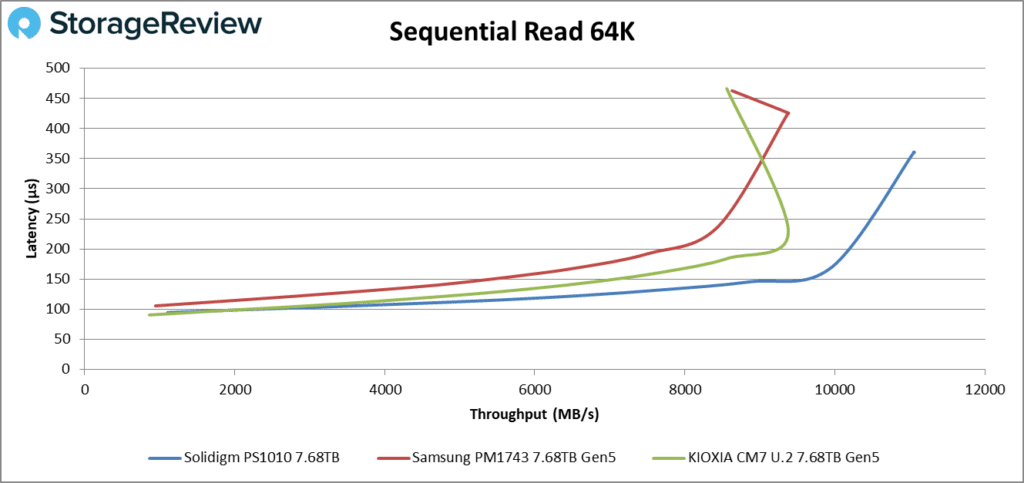
For the sequential Write 64K portion, the Solidigm PS1010 remains first with an impressive peak of 67K IOPS (or 4.17GB/s) at 953.7µs in latency.
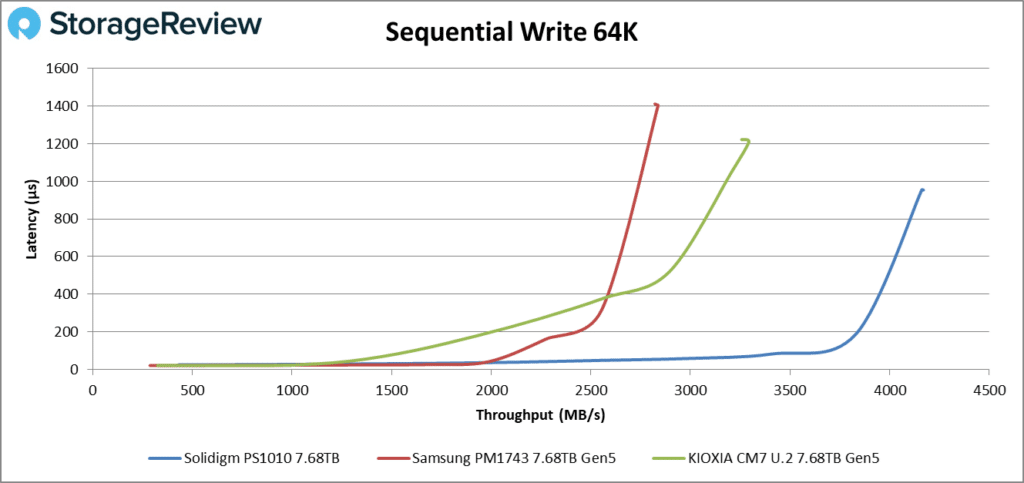
Mixed Workloads
Our first Mixed Workload test is the 4K 70/30 test, in which the Solidigm PS1010 showed 651K IOPS at only 97µs. This was good enough for second place, though it was well behind the KIOXIA’s peak of 881K IOPS.
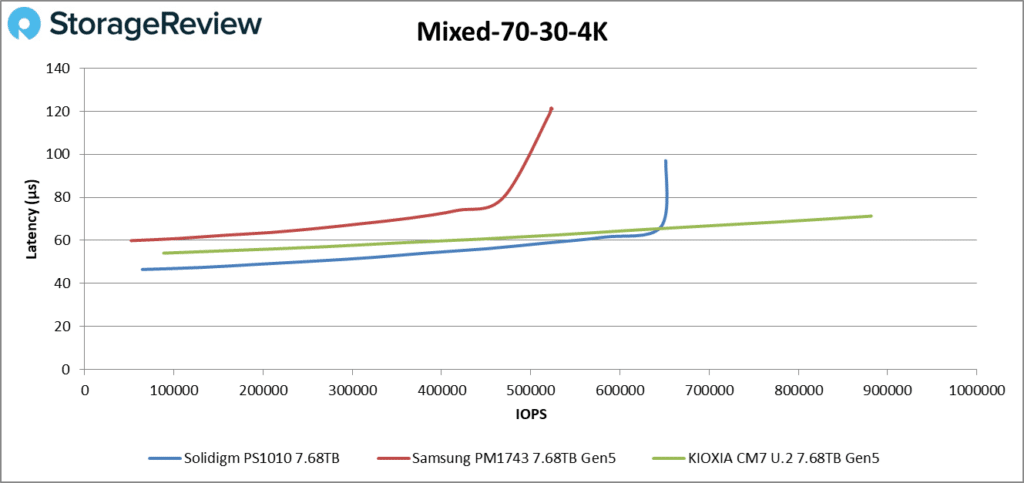 In the 8K 70/30 test, the Solidigm PS1010 inched closer to the KIOXIA drive with a peak of 545K IOPS at 116.2µs in latency.
In the 8K 70/30 test, the Solidigm PS1010 inched closer to the KIOXIA drive with a peak of 545K IOPS at 116.2µs in latency.
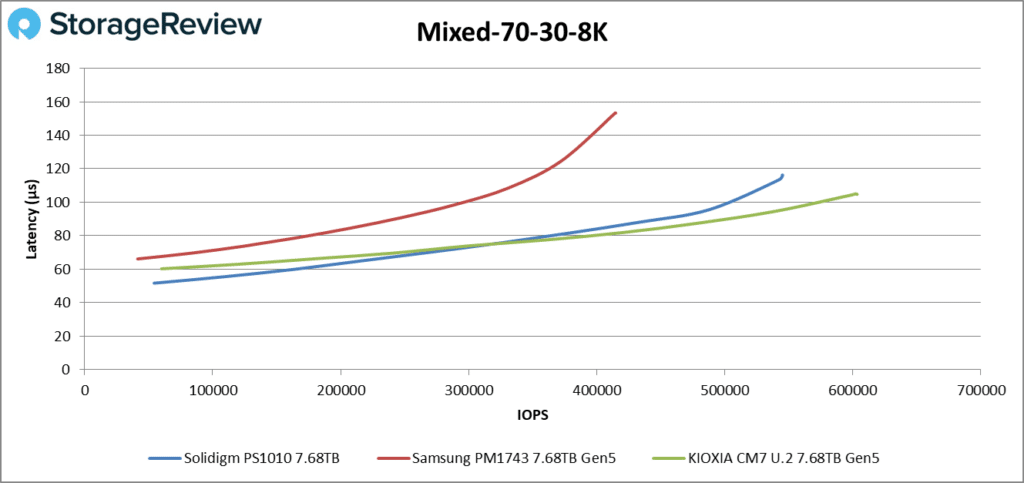
In our 16K portion, the Solidigm PS1010 jumped ahead with 404K IOPS at 78.8µs. The KIXOIA and Samsung drives were noticeably behind here, posting peaks of 329K IOPS and 290K IOPS, respectively.
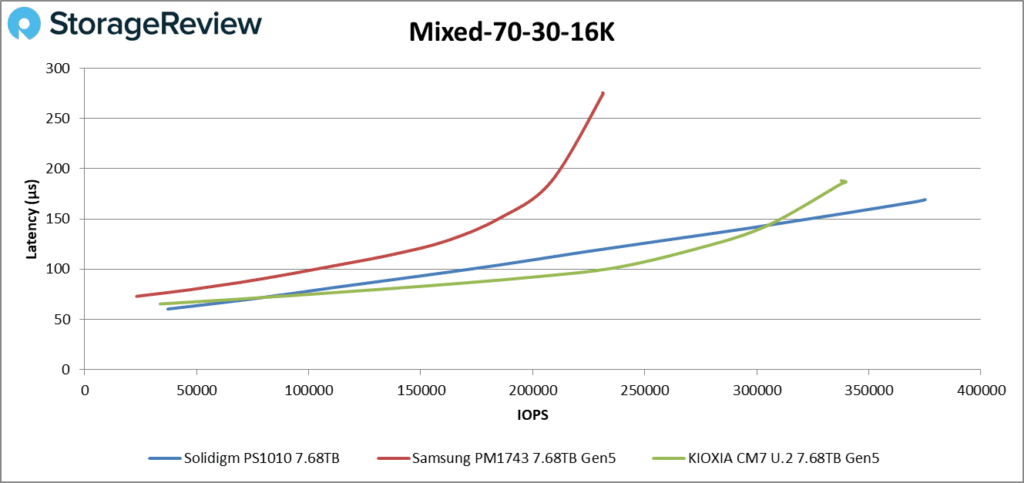
The Solidigm drive performed very well in the sequential 16K read test. In writes, it topped out at around 205K IOPS and ended the test with 75.3µs.
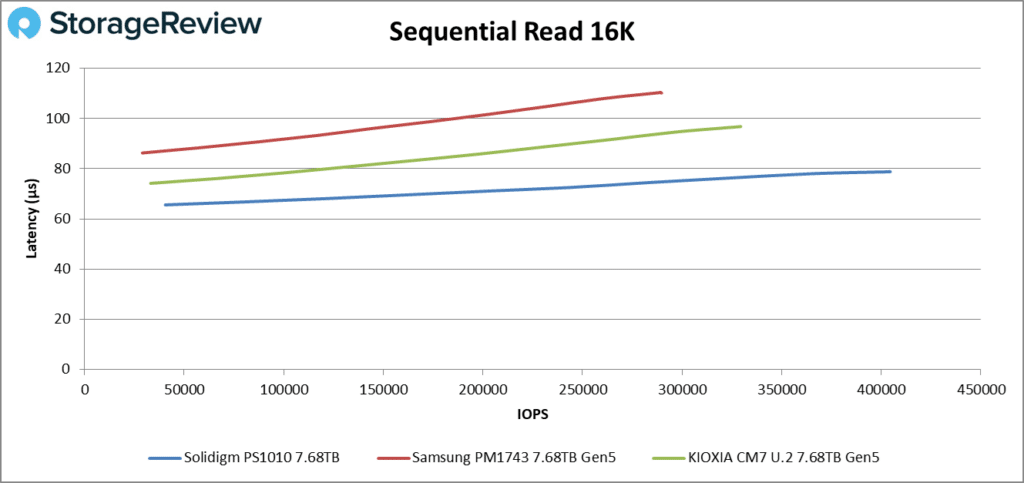 Once again, the Solidigm PS1010 was the leader in sequential 16 K reads, peaking at 404K IOPS with 78.8µs latency.
Once again, the Solidigm PS1010 was the leader in sequential 16 K reads, peaking at 404K IOPS with 78.8µs latency.
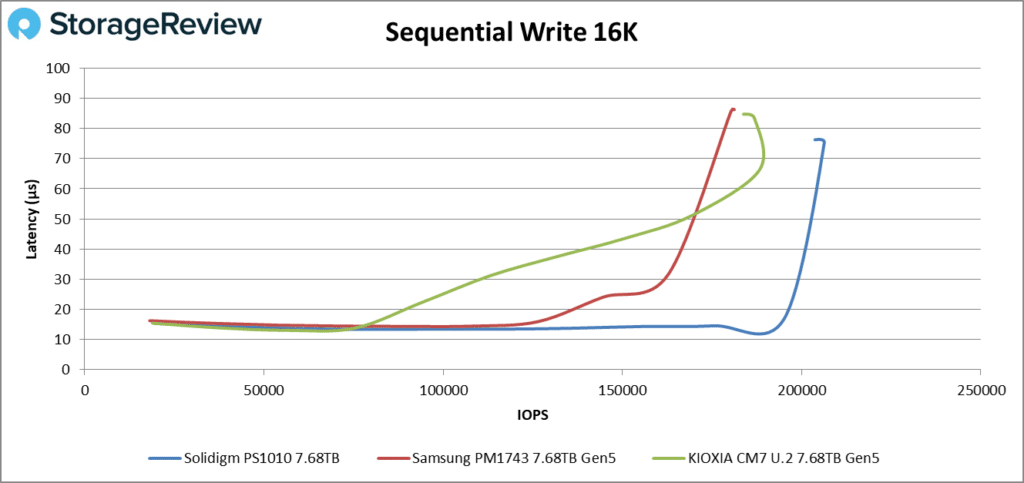
SQL Workloads
For our first SQL workload, the Solidigm PS1010 led with 451K IOPS at 70.6µs. The KIOXIA CM7 was second by a good margin with 396K IOPS at 80.5µs.
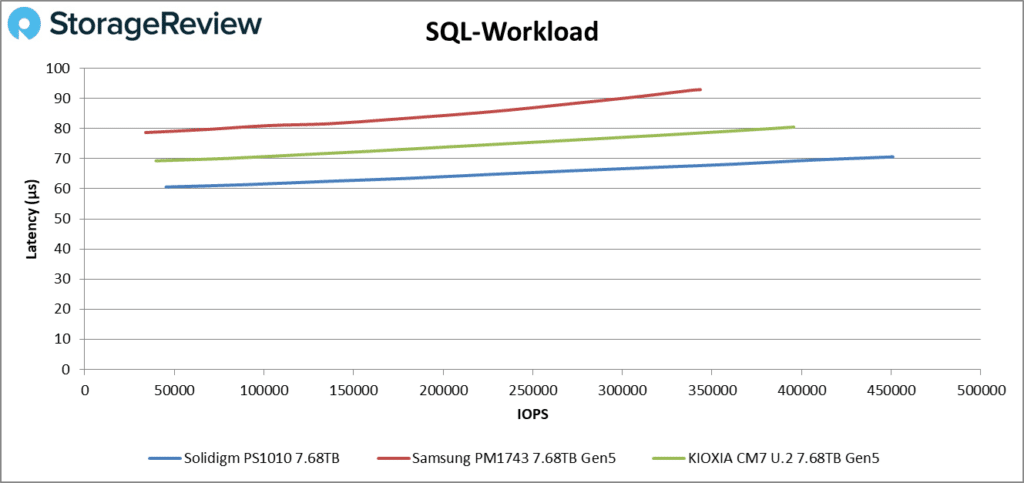 Moving to the SQL 90/10 portion, the PS1010 retained its top spot with 416K IOPS at 76.3µs in latency.
Moving to the SQL 90/10 portion, the PS1010 retained its top spot with 416K IOPS at 76.3µs in latency.
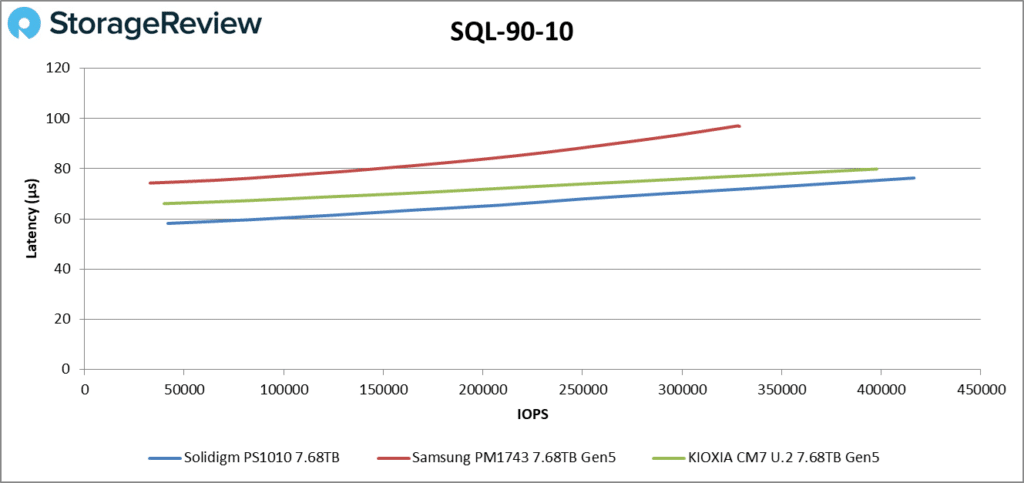
Last, the SQL 80/20 test, where the Solidigm drive fell back to second (though very close to the KIOXIA), posting 396K IOPS with a latency of 80.1µs.
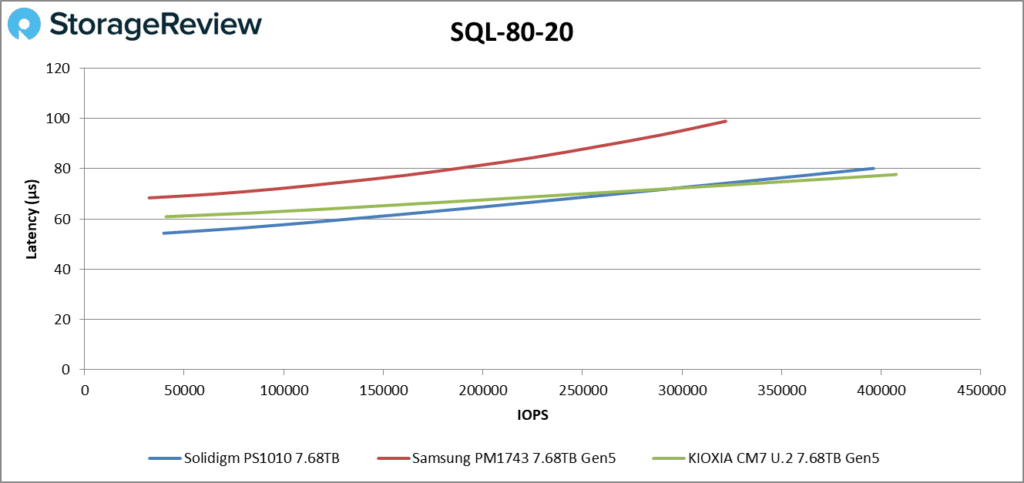
Oracle Workloads
For our first Oracle workload, the Solidigm PS1010 took second place with 393K IOPS at 89.9µs. The KIOXIA CM7 was the leading drive at 417K IOPS at 85.1µs.
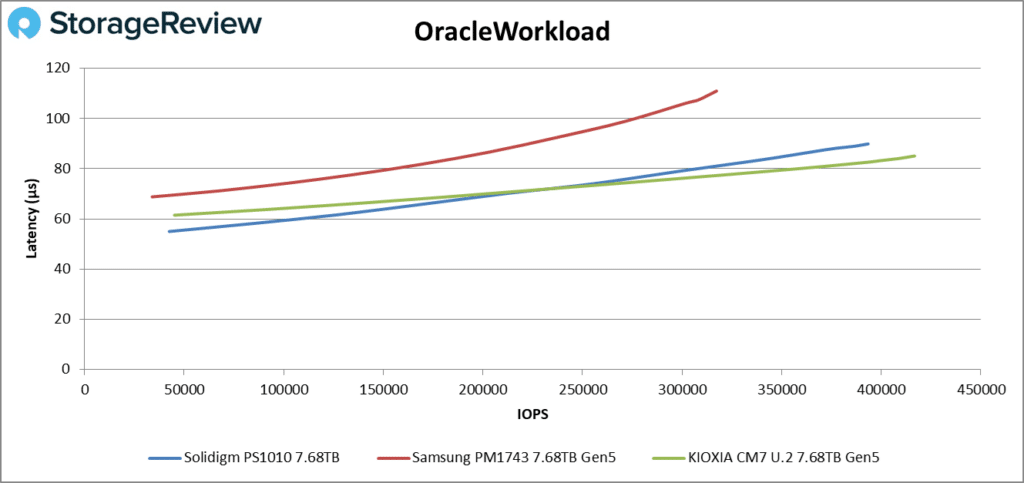 Next is the Oracle 90/10 workload, where the PS1010 took the top spot with 312K IOPS at 69.9µs in latency.
Next is the Oracle 90/10 workload, where the PS1010 took the top spot with 312K IOPS at 69.9µs in latency.
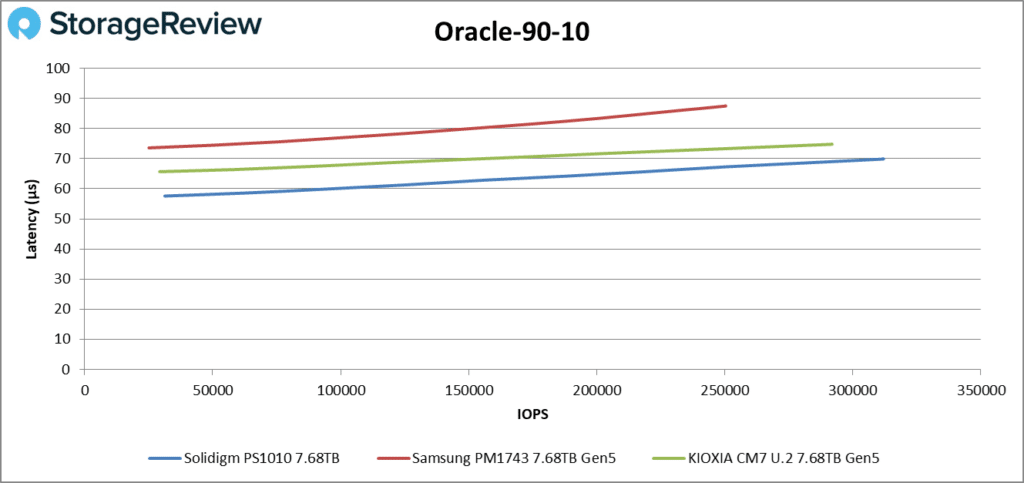
In the last 80/20 test, the Solidigm and KIOXIA drives had the same performance by the end of the test, with a peak of 304K IOPS with 71.6µs in latency.
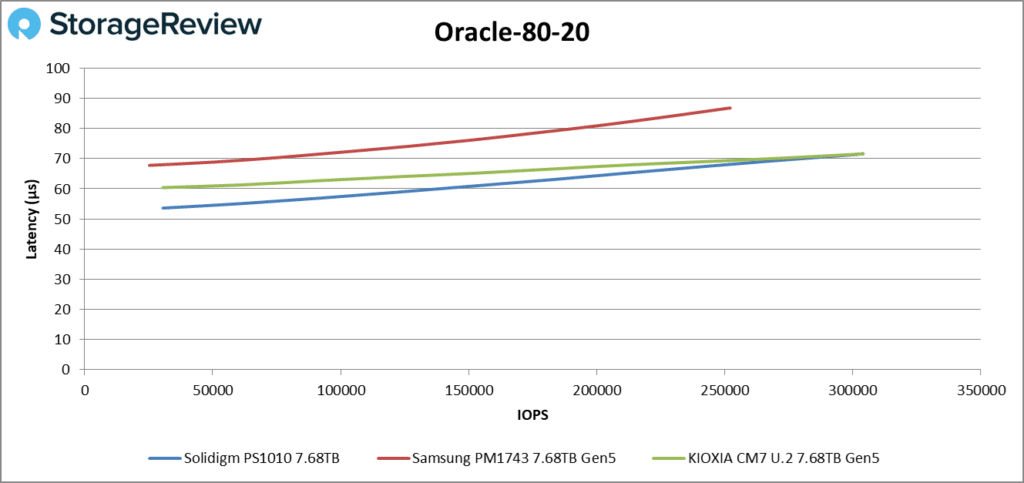
VDI Workloads
The VDI FC (Full Clone) tests are next up. In Boot, the new Solidigm drive peaked at an impressive 380K IOPS with 90.8µs in latency, which took the top spot. The CM7 is next with 348K IOPS at 99.1µs.
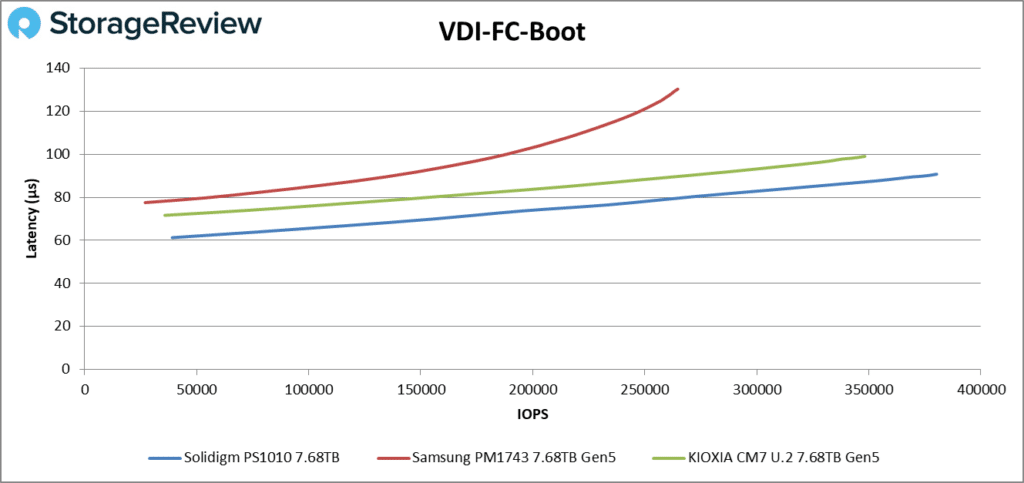 For the VDI FC Initial Login, the PS1010 was again the best-performing drive (by a wide margin), with 246K IOPS at 119.8µs. The next best drive was the KIOXIA, which posted just under 200K IOPS at 151µs in latency.
For the VDI FC Initial Login, the PS1010 was again the best-performing drive (by a wide margin), with 246K IOPS at 119.8µs. The next best drive was the KIOXIA, which posted just under 200K IOPS at 151µs in latency.
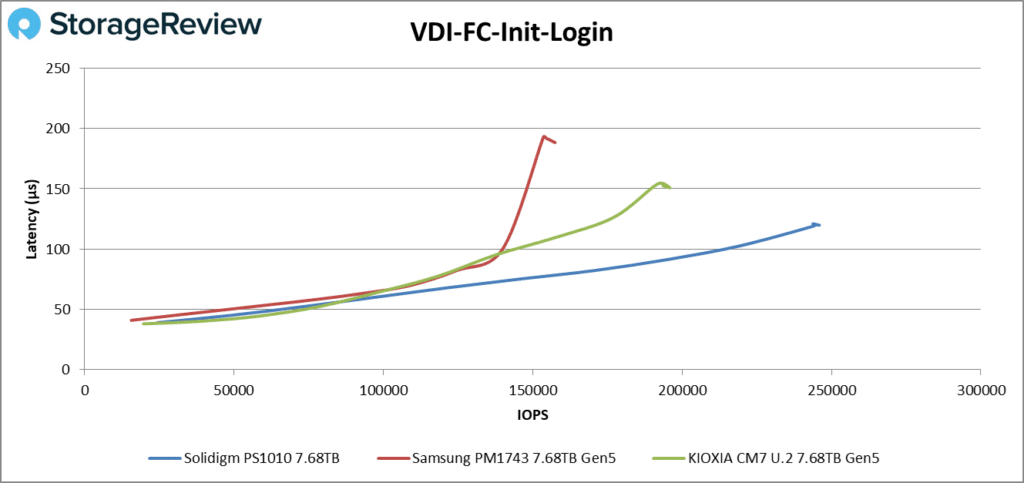
For VDI FC Monday Login, the PS1010 took second place with 147K IOPS at 107µs.
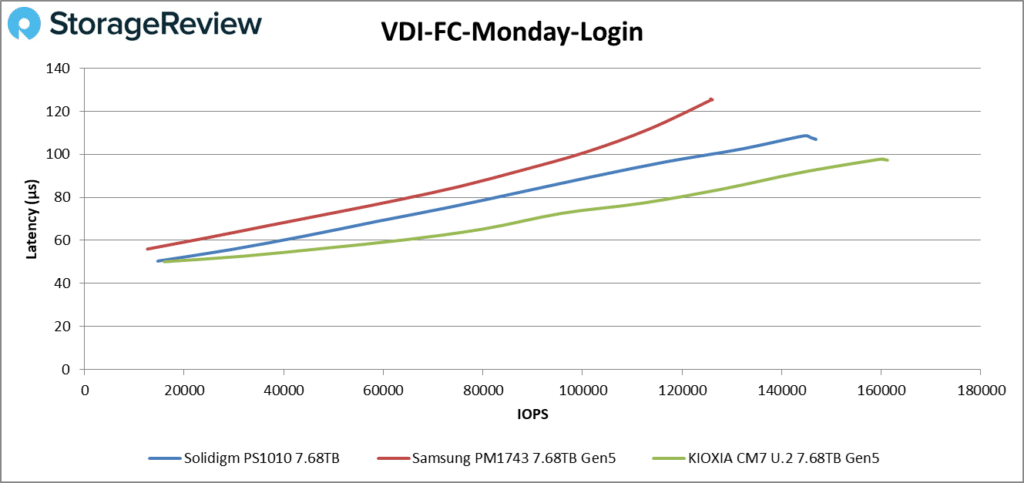
The last tests are our VDI LC (Linked Clone). First is Boot, where the PS1010 reclaimed the top spot with 175K IOPS at 91µs. The CM7 stayed relatively close with 160K IOPS at 99µs.
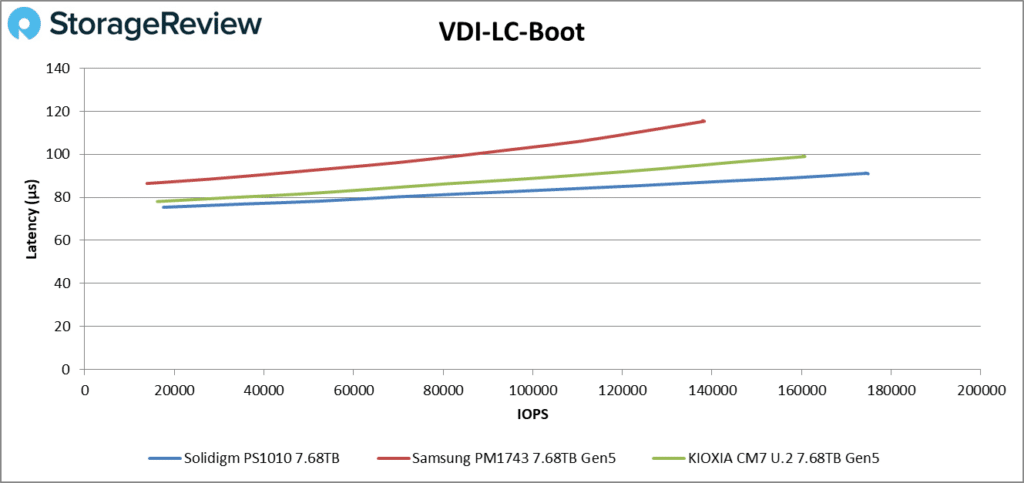 For VDI LC Initial Login, the Solidigm PS1010 fell back a bit, hitting 73K IOPS at 107.3ms–a tad better than the Samsung PM1748’s peak of 70K IOPS with 118µs latency. The CM7 took the lead here with 88K IOPS at 87.7µs.
For VDI LC Initial Login, the Solidigm PS1010 fell back a bit, hitting 73K IOPS at 107.3ms–a tad better than the Samsung PM1748’s peak of 70K IOPS with 118µs latency. The CM7 took the lead here with 88K IOPS at 87.7µs.
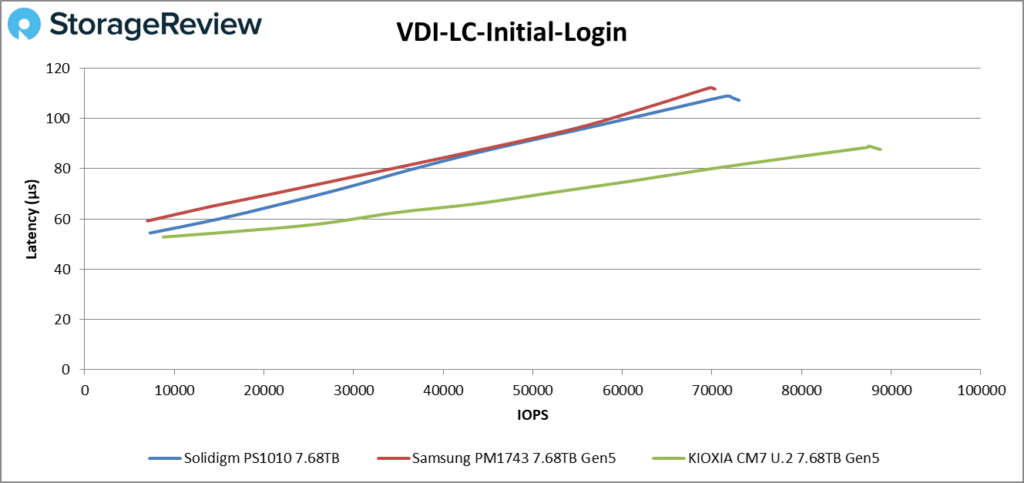
For our final test, we looked at the VDI LC Monday Login result, which showed that the Solidigm PS1010 was a hair behind the KIOXIA drive with 114K IOPS at 138.4µs in latency.
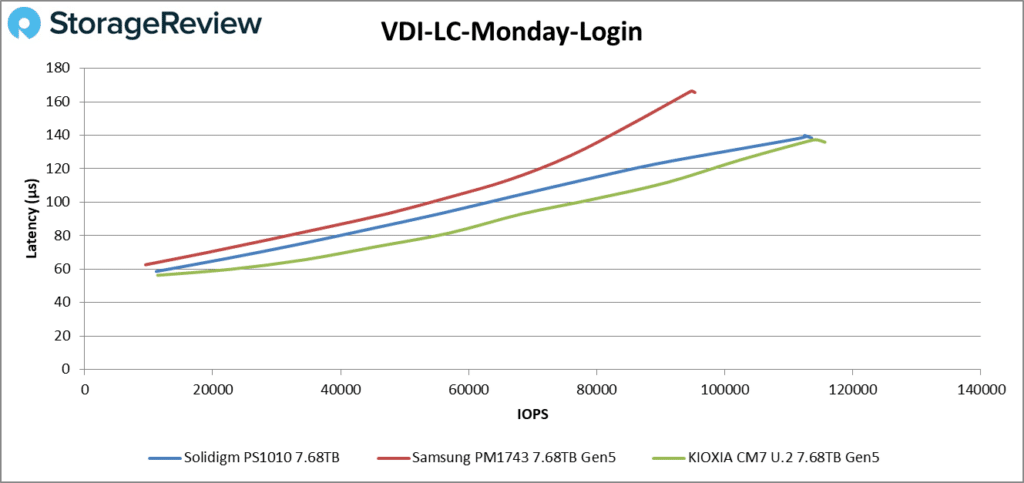
Conclusion
The Solidigm D7-PS1010 is a standout choice for enterprises looking to optimize their data center operations with high-performance Gen5 SSDs. Its impressive read and write speeds and robust security features make it well-suited for AI/ML data pipelines and other high-demand workloads. The drive’s ability to handle real-world IO conditions effectively ensures consistent performance across a range of various applications, from general-purpose servers to databases. In our four corners fio workloads, it outpaced the current 1DWPD Gen5 SSD comparables. Highlights include 14.8GB/s sequential read, 7.1GB/s write, and over 2M IOPS 4K random read.
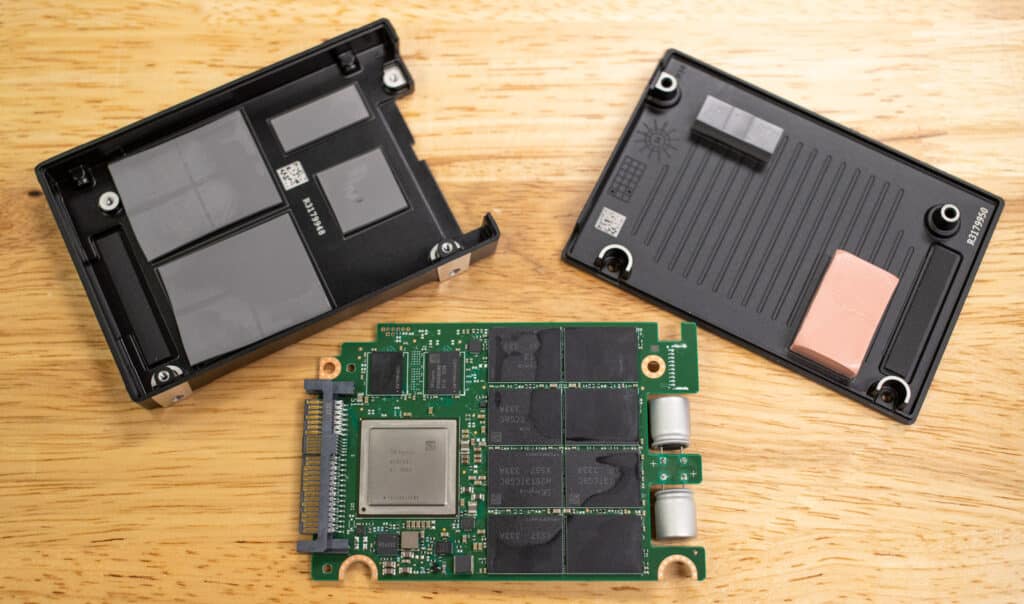
Solidigm PS1010 Disassembled
Additionally, the D7-PS1010’s advanced data protection features, such as enhanced power loss imminent (PLI) testing and robust end-to-end data protection with ECC, provide peace of mind regarding data integrity and reliability. The support for multiple power states and flexible form factors (U.2 and E3.S) adds to its versatility, allowing for energy efficiency and compatibility with a wide range of data center configurations.
Gen5 SSDs open up a new level of performance, critical for today’s AI, HPC, and other data-intensive workloads that take advantage of GPUs or other accelerators. The jump over Gen4 is tangible, organizations can fuel twice as many GPUs with the same number of drives compared to storage systems with Gen4 SSDs. Whether it’s an AI task or more common enterprise use cases, the Solidigm PS1010 does very well throughout our testing, demonstrating extremely competitive performance at the top of the Gen5 pack.
Engage with StorageReview
Newsletter | YouTube | Podcast iTunes/Spotify | Instagram | Twitter | TikTok | RSS Feed

